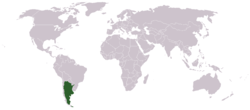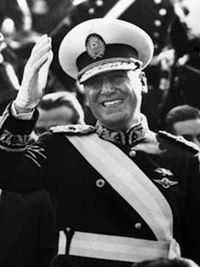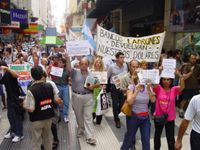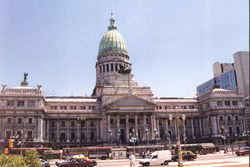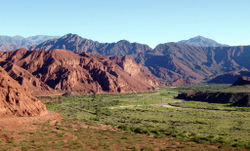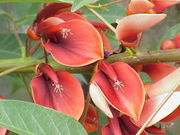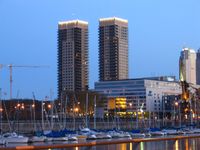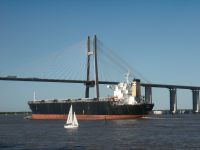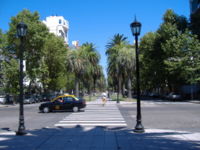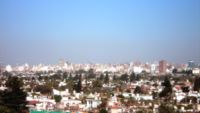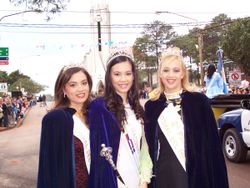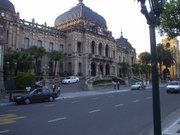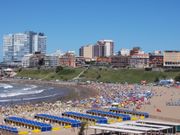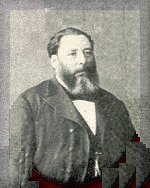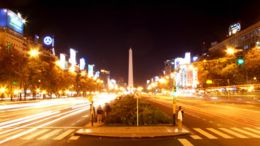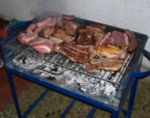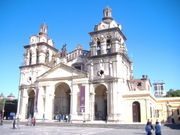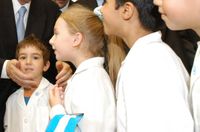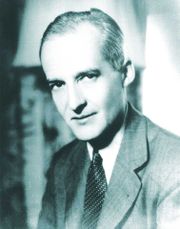Argentina
2007 Schools Wikipedia Selection. Related subjects: Central & South American Countries; Countries
| República Argentina Argentine Republic |
|||||
|
|||||
| Motto: Spanish: En Unión y Libertad (English: "In Union and Freedom") |
|||||
| Anthem: Himno Nacional Argentino | |||||
| Capital (and largest city) |
Buenos Aires |
||||
| Official languages | Spanish | ||||
|---|---|---|---|---|---|
| Government | Federal republic | ||||
| - President | Néstor Kirchner | ||||
| - Vice President | Daniel Scioli | ||||
| Independence | From Spain | ||||
| - May Revolution | 25 May 1810 | ||||
| - Declared | 9 July 1816 | ||||
| - Recognized | 1821 (by Portugal) | ||||
| Area | |||||
| - Total | 2,780,400 (1) km² ( 8th) 1,073,514 sq mi |
||||
| - Water (%) | 1.1 | ||||
| Population | |||||
| - 2006 estimate | 39,921,833 ( 32nd) | ||||
| - 2001 census | 36,260,130 | ||||
| - Density | 14/km² ( 195th) 36/sq mi |
||||
| GDP ( PPP) | 2006 estimate | ||||
| - Total | US $548.754 billion ( 22nd) | ||||
| - Per capita | US $14,838 ( 48th) | ||||
| HDI (2006) | |||||
| Currency | Peso ( ARS) |
||||
| Time zone | ART ( UTC-3) | ||||
| - Summer ( DST) | ARST ( UTC-3) | ||||
| Internet TLD | .ar | ||||
| Calling code | +54 | ||||
| (1) Argentina also has a territorial dispute with the United Kingdom over an additional 1,000,000 km² of Antarctica, the Falkland Islands and South Georgia and the South Sandwich Islands, for a total of 3,761,274 km² (1,452,236 sq mi). | |||||
Argentina is a country in southern South America. It ranks second in land area in South America, and eighth in the world.
Argentina occupies a continental surface area of 2,791,810 km² (1,078,000 sq mi) between the Andes mountain range in the west and the southern Atlantic Ocean in the east and south. It is bordered by Paraguay and Bolivia in the north, Brazil and Uruguay in the northeast, and Chile in the west and south. The country claims the British overseas territories of the Falkland Islands (Spanish: Islas Malvinas) and South Georgia and the South Sandwich Islands. Under the name of Argentine Antarctica, it claims 969,464 km² (374,312 sq mi) of Antarctica, overlapping other claims made by Chile and the United Kingdom.
The country is formally called the Argentine Republic (Spanish: República Argentina, IPA [reˈpuβlika aɾxenˈtina]). For many legal purposes, Nación Argentina (Argentine Nation) is used.
Origin and history of the name
"Argentina" derives from the Latin argentum (silver). When the first Spanish conquistadors discovered the Río de la Plata, they named the estuary Mar Dulce ('Sweet Sea', as in a fresh water sea). Indigenous people gave gifts of silver to the survivors of the shipwrecked expedition, who were led by Juan Díaz de Solís. The legend of Sierra del Plata — a mountain rich in silver — reached Spain around 1524, and the name was first seen in print on a Venice map from 1536. The source of the silver was the area where the city of Potosí was to be founded in 1546. An expedition that followed the trail of the silver up the Paraná and Pilcomayo rivers finally reached the source only to find it already claimed by explorers who reached it from Lima, the capital of the Viceroyalty.
The name Argentina was first used extensively in Ruy Díaz de Guzmán's 1612 book Historia del descubrimiento, población, y conquista del Río de la Plata (History of the discovery, population, and conquest of the Río de la Plata), naming the territory Tierra Argentina (Land of Silver).
History
The first signs of human presence in Argentina are located in the Patagonia ( Piedra Museo, Santa Cruz), and date from 11,000 BC. Around 1 AD, several corn-based civilizations developed in the western Andean region (Santa María, Huarpes, Diaguitas, Sanavirones, among others). In 1480 the Inca Empire, under the rule of emperor Pachacutec, launched an offensive and conquered present-day northwestern Argentina, integrating it into a region called Collasuyu. In the northeastern area, the Guaraní developed a culture based on yuca and sweet potato. The central and southern areas ( Pampas and Patagonia) were dominated by nomadic cultures, unified in the 17th century by the Mapuches.
Europeans arrived in 1502. Spain established a permanent colony on the site of Buenos Aires in 1580; the Viceroyalty of the Río de la Plata was created in 1776. In 1806 and 1807 the British Empire launched two invasions to Buenos Aires, but the creole population repelled both attempts. On May 25, 1810, after confirmation of the rumors about the overthrow of King Ferdinand VII by Napoleon, citizens of Buenos Aires took advantage of the situation and created the First Government Junta ( May Revolution). Formal independence from Spain was declared on July 9, 1816 in Tucumán. In 1817, General José de San Martín crossed the Andes to free Chile and Peru, thus eliminating the Spanish threat. Centralist and federalist groups (Spanish: Unitarios and Federales) were in conflict until national unity was established and the constitution promulgated in 1853.
Foreign investment and immigration from Europe led to the adoption of modern agricultural techniques. In the 1880s, the " Conquest of the Desert" subdued or exterminated the remaining indigenous tribes throughout the southern Pampas and Patagonia.
From 1880 to 1930, Argentina enjoyed increasing prosperity and prominence through an export-led economy, and the population of the country swelled sevenfold. Conservative forces dominated Argentine politics until 1916, when their traditional rivals, the Radicals, won control of the government. The military forced Hipólito Yrigoyen from power in 1930, leading to another decade of Conservative rule. Political change led to the presidency of Juan Perón in 1946, who tried to empower the working class and greatly expanded the number of unionized workers. The Revolución Libertadora of 1955 deposed him.
From the 1950s to 1970s, soft military and weak civilian administrations traded power. During those years the economy grew strongly and poverty declined (less than 7% in 1975), but became increasingly protectionist. At the same time political violence continued to escalate. In 1973, Perón returned to the presidency, but he died within a year of assuming power. His third wife Isabel, the Vice President, succeeded him in office, but the military coup of March 24, 1976 removed her from office.
The armed forces took power through a junta in charge of the self-appointed National Reorganization Process until 1983. The military government repressed opposition and terrorist leftist groups using harsh illegal measures (the " Dirty War"); thousands of dissidents " disappeared", while the SIDE cooperated with DINA and other South American intelligence agencies, and with the CIA in Operation Condor. Many of the military leaders that took part in the Dirty War were trained in the U.S.-financed School of the Americas, among them Argentine dictators Leopoldo Galtieri and Roberto Viola. Economic problems, charges of corruption, public revulsion in the face of human rights abuses and, finally, the country's 1982 defeat by the British in the Falklands War discredited the Argentine military regime.
Democracy was restored in 1983. Raúl Alfonsín's Radical government took steps to account for the "disappeared", established civilian control of the armed forces, and consolidated democratic institutions. The members of the three military juntas were prosecuted and sentenced to life terms. Failure to resolve endemic economic problems and an inability to maintain public confidence led to Alfonsín's early departure six months before his term was to be completed.
President Carlos Menem imposed a peso-dollar fixed exchange rate in 1991 to stop hyperinflation and adopted far-reaching market-based policies, dismantling protectionist barriers and business regulations, and implementing a privatization program. These reforms contributed to significant increases in investment and growth with stable prices through most of the 1990s.
The Menem and de la Rúa administrations faced diminished competitiveness of exports, massive imports which damaged national industry and reduced employment, chronic fiscal and trade deficits, and the contagion of several economic crises. The Asian financial crisis in 1998 precipitated an outflow of capital that mushroomed into a recession, and culminated in a financial panic in November of 2001. The next month, amidst bloody riots, President de la Rúa finally resigned.
In two weeks, several presidents followed in quick succession, culminating in Eduardo Duhalde being appointed interim President of Argentina by the Legislative Assembly on 2 January 2002. Argentina defaulted on its international debt obligations. The peso's almost 11-year-old linkage to the U.S. dollar was abandoned, resulting in major depreciation of the peso and a spike in inflation.
With a more competitive and flexible exchange rate, the country started implementing new policies based on re-industrialization, import substitution, increased exports, and consistent fiscal and trade surpluses. By the end of 2002, the economy began to stabilize. In 2003, Néstor Kirchner was elected president. During Kirchner's presidency, Argentina restructured its defaulted debt with a steep discount (about 75 percent) on most bonds, paid off outstanding debts with the International Monetary Fund, renegotiated contracts with utilities, and nationalized some previously privatized industries. Currently, Argentina is enjoying a period of high economic growth and increased political stability.
Politics
Government
Argentina's political framework is a federal presidential representative democratic republic, in which the President of Argentina is both head of state and head of government, complemented by a pluriform multi-party system. Argentina's current president (2006) is Néstor Kirchner, with Daniel Scioli as vice president. The Argentine Constitution of 1853 mandates a separation of powers into executive, legislative, and judicial branches at the national and provincial level.
Executive power resides in the President and his cabinet. The President and Vice President are directly elected to 4-year terms, limited to two consecutive terms, and the cabinet ministers are appointed by the president.
Legislative power is vested in the bicameral National Congress or Congreso de la Nación, consisting of a Senate ( Senado) of 72 seats, and a Chamber of Deputies ( Cámara de Diputados) of 257 members. Senators serve 6-year terms, with one-third standing for reelection every 2 years. Members of the Chamber of Deputies are directly elected to 4-year term via a system of proportional representation, with half of the members of the lower house being elected every 2 years. A third of the candidates presented by the parties must be women.
The judiciary is independent of the executive and the legislature. The Argentine Supreme Court of Justice has 9 members who are appointed by the President in consultation with the Senate. The rest of the judges are appointed by the Council of Magistrates of the Nation, a secretariat composed of representatives of judges, lawyers, the Congress, and the executive. (see also law of Argentina)
Foreign relations
Argentina is a member of Mercosur, an international bloc which has some legislative supranational functions. Mercosur is composed of five full members: Argentina, Brazil, Paraguay, Uruguay, and Venezuela. It has five associate members without full voting rights: Bolivia, Chile, Colombia, Ecuador, and Peru.
Argentina was the only country from Latin America to participate in the 1991 Gulf War under mandate of the United Nations, and in every phase of the Haiti operation. It has also contributed worldwide in peacekeeping operations, including in El Salvador-Honduras-Nicaragua, Guatemala, Ecuador-Peru, Western Sahara, Angola, Kuwait, Cyprus, Croatia, Kosovo, Bosnia and Timor Leste. In recognition of its contributions to international security, U.S. President Bill Clinton designated Argentina as a major non-NATO ally in January 1998. In 2005, it was elected as a temporary member of the UN Security Council.
In 2005, on November 4 and November 5, the Argentine city of Mar del Plata hosted the Fourth Summit of the Americas. This summit was marked by a number of anti-U.S. protests. As of 2006, Argentina has been emphasizing Mercosur as its first international priority; by contrast, during the 1990s, it relied more heavily on its relationship with the United States.
Argentina has long claimed sovereignty over the Falkland/Malvinas Islands, the South Shetland Islands, the South Sandwich Islands and almost 1 million km² in Antarctica, between the 25°W and the 74°W meridians and the 60°S parallel. This slice of the continent is known as Argentine Antarctica, which Argentina considers part of the national territory. For more than a century, there has been an Argentine presence at the Orcadas Base.
Argentina is a founding signatory and permanent consulting member of the Antarctic Treaty System and the Antarctic Treaty Secretariat is established in Buenos Aires
Military
The President is the Commander-in-Chief, and the military is under the control of the Defense Ministry. Argentina's military establishement has historically been one of the best equipped in the region (for example, developing its own advanced jet fighters as early as the 1950s), but has faced expenditure cutbacks in comparison to other regional militaries. The age of allowable military service is 18 years; there is no obligatory military service and currently no conscription.
The military is composed of a traditional Army, Navy, and Air Force. Controlled by a separate ministry (the Interior Ministry), Argentine territorial waters are patrolled by the Naval Prefecture, and the border regions by the National Gendarmerie; both branches however maintain liasions with the Defense Ministry. They mostly perform patrols against organized crime, drug smuggling, and rescue operations of civilians in distress. Argentina's Armed Forces are currently performing major operations in Haiti and Cyprus, in accordance to specified UN mandates.
Administrative divisions

Argentina is divided into 23 provinces (provincias; singular: provincia), and 1 autonomous city (commonly known as capital federal but constitutionally: "Capital de la República" or "Capital de la Nación"), marked with an asterisk:
|
|
* The current official name for the federal district is Ciudad Autónoma de Buenos Aires.
Buenos Aires has been the capital of Argentina since its unification, but there have been projects to move the administrative centre elsewhere. During the presidency of Raúl Alfonsín a law was passed ordering the transfer of the federal capital to Viedma, a city in the Patagonian province of Río Negro. Studies were underway when economic problems killed the project in 1989. Though the law was never formally repealed, it has become a mere historical relic, and the project has been forgotten.
Provinces are divided into smaller secondary units called departamentos, or departments. There are 376 departments. The province of Buenos Aires has 134 similar divisions known as partidos. Departamentos and partidos are further subdivided into municipalities or districts.
In descending order by number of inhabitants, the major cities in Argentina are Buenos Aires, Córdoba, Rosario, Mendoza, Tucumán, La Plata, Mar del Plata, Salta, Santa Fe, San Juan, Resistencia, and Neuquén.
Geography
Main features
The total surface area of Argentina (not including the Antarctic claim), is as follows:
- Total: 2,766,890 km²
- Land: 2,736,691 km²
- Water: 30,200 km²
Argentina is nearly 3,700 km long from north to south, and 1,400 km from east to west (maximum values). It can roughly be divided into four parts: the fertile plains of the Pampas in the centre the country, the source of Argentina's agricultural wealth; the flat to rolling, oil-rich plateau of Patagonia in the southern half down to Tierra del Fuego; the subtropical flats of the Gran Chaco in the north, and the rugged Andes mountain range along the western border with Chile.
The highest point above sea level in Argentina is located in Mendoza. Cerro Aconcagua, at 6,962 meters (22,834 feet), is the highest mountain in the Americas, the Southern, and Western Hemisphere. The lowest point is Laguna del Carbón in Santa Cruz, −105 meters (−344 feet) below sea level. This is also the lowest point on the South American continent. The geographic centre of the country is located in south-central La Pampa province.
The country has a territorial claim over a portion of Antarctica, where it has maintained a constant occupied presence for more than a century, starting in 1904.
Geographic regions
The country is traditionally divided into several major geographically distinct regions:
- Pampas: The plains west and south from Buenos Aires are some of the most fertile in the world. Called the Humid Pampa, they cover most of the provinces of Buenos Aires and Córdoba, and big portions of the provinces of Santa Fe and La Pampa. The western part of La Pampa and the province San Luis also have plains (the Dry Pampa), but they are drier and used mainly for grazing. The Sierra de Córdoba in the homonymous province (extending into San Luis), is the most important geographical feature of the pampas.
- Gran Chaco: The Gran Chaco region in the north of the country is seasonal dry/wet, mainly cotton growing and livestock raising. It covers the provinces of Chaco and Formosa. It is dotted with subtropical forests, scrubland, and some wetlands, home to a large number of plant and animal species. The province of Santiago del Estero lies in the drier region of the Gran Chaco.
- Mesopotamia: The land between the Paraná and Uruguay rivers is called Mesopotamia and it is shared by the provinces of Corrientes and Entre Ríos. It features flatland apt for grazing and plant growing, and the Iberá Wetlands in central Corrientes. Misiones province is more tropical and belongs within the Brazilian Highlands geographic feature. It features subtropical rainforests and the Iguazú Falls.
- Patagonia: The steppes of Patagonia, in the provinces of Neuquén, Río Negro, Chubut and Santa Cruz, are of Tertiary origin. Most of the region is semiarid in the north to cold and arid in the far south, but forests grow in its western fringes which are dotted with several large lakes. Tierra del Fuego is cool and wet, moderated by oceanic influences. Northern Patagonia (roughly Río Negro south of the homonymous river, and Neuquén) can also be referred as the Comahue region (not commonly in use).
- Cuyo: West-central Argentina is dominated by the imposing Andes Mountains. To their east is the arid region known as Cuyo. Melting waters from high in the mountains form the backbone of irrigated lowland oasis, at the centre of a rich fruit and wine growing region in Mendoza and San Juan provinces. Further north the region gets hotter and drier with more geographical accidents in La Rioja province.
- NOA or Noroeste: This region is the highest in average elevation. Several parallel mountain ranges, several of which have peaks higher than 20,000 feet, dominate the area. These ranges grow wider in geographic extent towards the north. They are cut by fertile river valleys, the most important being the Calchaquí Valleys in the provinces of Catamarca, Tucumán, and Salta. Farther north the province of Jujuy near Bolivia lies mainly within the Altiplano plateau of the Central Andes. The Tropic of Capricorn goes through the far north of the region.
Rivers and lakes
Major rivers in Argentina include the Pilcomayo, Paraguay, Bermejo, Colorado, Río Negro, Salado, Uruguay and the largest river, the Paraná. The latter two flow together before meeting the Atlantic Ocean, forming the estuary of the Río de la Plata. Regionally important rivers are the Atuel and Mendoza in the homonymous province, the Chubut in Patagonia, the Río Grande in Jujuy, and the San Francisco River in Salta.
There are several large lakes in Argentina, many of them in Patagonia. Among these are lakes Argentino and Viedma in Santa Cruz, Nahuel Huapi in Río Negro and Fagnano in Tierra del Fuego, and Colhué Huapi and Musters in Chubut. Lake Buenos Aires and O'Higgins/San Martín Lake are shared with Chile. Mar Chiquita, Córdoba, is the largest salt water lake in the country. There are numerous reservoirs created by dams. Argentina features various hot springs, such as those at Termas de Río Hondo with temperatures between 30°C and 65°C.
Coastal areas and seas
Argentina has 2,665 kilometers (1,656mi) of coastline. The continental platform is unusually wide; in Argentina this shallow area of the Atlantic Ocean is called Mar Argentino. The waters are rich in fisheries and suspected of holding important hydrocarbon energy resources. Argentina's coastline varies between areas of sand dunes and cliffs. The two major ocean currents affecting the coast are the warm Brazil Current and the cold Falkland Current (Spanish: corriente Antártica). Because of the uneveness of the coastal landmass, the two currents alternate in their influence on climate and do not allow temperatures to fall evenly with higher latitude. The southern coast of Tierra del Fuego forms the north shore of the Drake Passage.
Climate
Because of longitudinal and elevation amplitudes, Argentina is subject to a variety of climates. As a rule, the climate is predominantly temperate with extremes ranging from subtropical in the north to subpolar in the far south. The north of the country is characterized by very hot, humid summers with mild drier winters, and is subject to periodic droughts. Central Argentina has hot summers with thunderstorms (in western Argentina producing some of the world's largest hail), and cool winters. The southern regions have warm summers and cold winters with heavy snowfall, specially in mountainous zones. Higher elevations at all latitudes experience cooler conditions.
The hottest and coldest temperature extremes recorded in South America have occurred in Argentina. A record high temperature of 48.8 °C (120 °F), was recorded at Rivadavia, Salta on December 11, 1905. The lowest temperature recorded was −32.7 °C (−27 °F) at Sarmiento, Chubut, June 1st, 1907.
Major winds in Argentina include the cool Pampero blowing on the flat plains of Patagonia and the Pampas after a cold front; the Viento Norte, a warm wind that can blow from the north in mid and late winter creating mild conditions; and the Zonda, a hot and dry wind ( see Föhn wind), affecting west-central Argentina. Squeezed of all moisture during the 6,000 meter descent from the Andes, Zonda winds can blow for hours with gusts up to 120 km/h, fueling wildfires and causing damage. When the Zonda blows (June-November), snowstorms and blizzard (viento blanco) conditions usually affect the higher elevations.
The Sudestada (literally "southeaster") could be considered similar to the Noreaster, though snowfall is rarely involved (but is not unprecedented). Both are associated with a deep winter low pressure system. The sudestada usually moderates cold temperatures but brings very heavy rains, rough seas, and coastal flooding. It is most common in late autumn and winter along the coasts of central Argentina and in the Río de la Plata estuary.
The southern regions, particularly the far south, experience long periods of daylight from November to February (up to 19 hours), and extended nights from May to August. All of Argentina uses UTC-3 time zone. The country does not observe daylight savings.
Extreme points
Argentina's eastermost continental point is northeast of the town of Bernardo de Irigoyen, Misiones (), the westernmost in the Mariano Moreno Range in Santa Cruz (). The northermost point is located at the confluence of the Grande de San Juan and Mojinete rivers, Jujuy (), and the southernmost is Cape San Pío in Tierra del Fuego ().
Enclaves and exclaves
There is one Argentine exclave, the Martín García Island (co-ordinates ). It is near the confluence of the Paraná and Uruguay rivers, a kilometre (0.62 mi) inside Uruguayan waters, and 3.5 kilometres (2.1 mi) from the Uruguayan coastline near the small town of Martín Chico (itself halfway between Nueva Palmira and Colonia del Sacramento).
An agreement reached by Argentina and Uruguay in 1973 reaffirmed Argentine jurisdiction over the island, ending a century-old dispute. Under the terms of the agreement, Martín García is to be devoted exclusively as a natural preserve. Its area is about 2 square kilometres (500 acres), and its population is about 200 people.
Flora and fauna
Vegetation
Subtropical plants dominate the north, part of the Gran Chaco region of South America. The genus Dalbergia of trees is well disseminated with representatives like the Brazilian Rosewood and the quebracho tree; also predominant are white and black algarrobo trees ( prosopis alba and prosopis nigra). Savannah-like areas exist in the drier regions nearer the Andes. Acquatic plants thrive in the wetlands dotting the region.
In central Argentina the humid pampas are a true tallgrass prairie ecosystem. The original pampa had virtually no trees; today along roads or in towns and country estates (estancias), some imported species like the American sycamore or eucalyptus are present. The only tree-like plant native to the pampa is the ombú, an evergreen. The surface soils of the pampa are a deep black colour, primarily humus, known commonly as compost. It is this which makes the region one of the most agriculturaly productive on Earth. However, this is also responsible for decimating much of the original ecosystem, to make way for commercial agriculture. The western pampas receive less rainfall, this dry pampa is a plain of short grasses or steppe.
Most of Patagonia in the south lies within a rain shade of the Andes. The plantlife, shrubby bushes and plants, is well suited to withstand dry conditions. The soil is hard and rocky making large-scale farming impossible except along river valleys. Coniferous forests grow in far western Patagonia and on the island of Tierra del Fuego. Conifers native to the region include alerce (Fitzroya cupressoides), ciprés de la cordillera (Austrocedrus chilensis), ciprés de las guaitecas (Pilgerodendron uviferum), huililahuán (Podocarpus nubigenus), lleuque (Prumnopitys andina), mañío hembra (Saxegothaea conspicua), and pehuén (Araucaria araucana), while native broadleaf trees include several species of Nothofagus including coigüe or coihue, lenga (Nothofagus pumilio), ñire (Nothofagus antarctica). Other introduced trees present in forestry plantations include spruce, cypress, and pine. Common plants are the copihue and colihue ( Chusquea coleou).
In Cuyo, semiarid thorny bushes and other xerophile plants abound. Along the many river oasis, grasses and trees grow in significant numbers. The area presents optimal conditions for the large scale growth of grape vines. In the northwest of Argentina there are many species of cactii. In the highest elevations (often above 4,000mts), no vegetation grows due to the extreme altitude, and the soils are virtually devoid of any plant life.
The ceibo flower (belonging to the tree Erythrina crista-galli), is the national flower of Argentina.
Animal life
Many species live in the subtropical north. Big cats like the jaguar, puma, and ocelot; primates ( howler monkey); large reptiles ( crocodiles), and a species of caiman. Other animals include the tapir, capybara, anteater, ferret, raccoon, and various species of turtle and tortoise. There are many birds, notably hummingbirds, flamingos, toucans, and parrots.
The central grasslands are populated by the armadillo, pampas cat, and the rhea (ñandú), a flightless bird. Hawks, falcons, herons, partridges inhabit the region. There are also deer and foxes. Some of these species extend into Patagonia.
The western mountains are home to different animals. These include the llama, guanaco, vicuña, among the most recognizable species of South America. Also in this region are the jackal, andean cat, and the largest flying bird in the New World, the condor.
Southern Argentina is home to the puma, huemul, pudú (the world's smallest deer), and wild boar. The coast of Patagonia is rich in animal life: elephant seals, fur seals, sea lions, and species of penguin. The far south is populated by cormorant birds.
The territorial waters of Argentina have abundant ocean life; mammals such as dolphins, orcas, and whales like the southern right whale, a major tourist draw for naturalists. Sea fish include sardines, argentine hakes, dolphinfish, salmon, and sharks; also present are squid and spider crab (centolla) in Tierra del Fuego. Rivers and streams in Argentina have many species of trout and the South American dorado fish. Outstanding snake species inhabiting Argentina include boa constrictors, and the very venomous yacará pit viper and south American rattle snake.
The Hornero was elected the National Bird after a survey in 1928.
Economy
Recent developments
Argentina benefits from rich natural resources, a highly literate population, an export-oriented agricultural sector, and a diversified industrial base. The country historically had a large middle class compared to other Latin American countries, but this segment of the population was decimated by a succession of economic crises. Today, while a significant segment of the population is still financially well-off, they stand in sharp contrast with millions who have seen their purchasing power drastically reduced. Since 2002, there has been an improvement in the situation of the poorer sectors and a strong rebound of the middle class.
Since the late 1970s, the country piled up public debt and was plagued by bouts of high inflation. In 1991, the government pegged the peso to the U.S. dollar and limited the growth in the monetary base. The government then embarked on a path of trade liberalization, deregulation, and privatization. Inflation dropped and the gross domestic product grew, but external economic shocks and failures of the system diluted its benefits, causing it to crumble in slow motion, from 1995 and up to the collapse in 2001.
By 2002, Argentina had defaulted on its debt, its GDP had shrunk, unemployment was more than 25%, and the peso had depreciated 75% after being devalued and floated. However, careful spending control and heavy taxes on now-soaring exports gave the state the tools to regain resources and conduct monetary policy.
In 2003, import substitution policies and soaring exports coupled with lower inflation and expansive economic measures, triggered a surge in the GDP. It was repeated in 2004 and 2005, creating millions of jobs and encouraging internal consumption. Capital flight decreased, and foreign investment slowly returned. The influx of foreign currency from exports created a huge trade surplus. The Central Bank was forced to buy dollars from the market, and continues to do a various times today to be accumulated as reserves. It does this to prevent the argentine peso from appreciating significantly and cutting competitiveness.
The situation by 2006 was further improved, the year is on track to match the large GDP growth of the last three (predictions are between 8.5% and 9.0%), though inflation, estimated at around 10 to 12%, has become an issue again, and income distribution is still considerably unequal. In a variety of reports, internationals organizations criticize Argentina for remaining a somewhat closed economy.
Even as the effects of the crisis have abated but not disappeared, Argentina remains one of the most developed countries in Latin America. Even though the income distribution is an important pending problem, it boasts the highest GDP per capita based on purchasing power parity, and the 3rd highest in US$ (nominal) GDP. The country enjoys the highest levels of education measured by university attendance, and a reasonable infrastructure that in many aspects equals that found in fully industrialized nations.
In 2002, 57,5% of the population was below the poverty line, but the last report of August 2006 showed a 31,4% poverty level. Similarly, unemployment was more than 25 percent, by July 2006 it was 10.2 percent. GDP per capita has surpassed the previous pre-recession peak of 1998 in PPP, but still lags in nominal GDP, mostly due to an undervalued currency. The economy grew 8.9 percent in 2003, 9.0 percent in 2004, and 9.2 percent in 2005. As of 2006 foreign debt stands at 68 percent of GDP and is slowly decreasing.
Sectors
In 2004, agricultural output accounted for 11% of GDP, and one third of all exports. Soy and vegetable oils are major export commodities at 24% of exports. Wheat, maize, oats, sorghum, and sunflower seeds totalled 8%. Cattle is also a major industry. Beef, milk, leather products, and cheese were 6% of total exports. Sheep and wool industries are important in Patagonia, pigs and caprines elsewhere.
Fruits and vegetables made up 3% of exports: apples and pears in the Río Negro valley; oranges and other citrus in the northwest and Mesopotamia; grapes and strawberries in Cuyo, and berries in the far south. Cotton and yerba mate are major crops in the Gran Chaco, sugarcane and tobacco in the northwest, and olives and garlic in Cuyo. Bananas ( Formosa), tomatoes ( Salta), and peaches (Mendoza) are grown for domestic consumption. Argentina is the world's 5th wine producer, and fine wine production has taken major leaps in quality. A growing export, total viticulture potential is far from met. Mendoza is the largest wine region, followed by San Juan.
Industrial petrochemicals, oil, and natural gas are Argentina's 2nd group of exports, 20% of totals. The most important oil fields lie in Patagonia and Cuyo. An impressive network of pipelines send raw product to Bahia Blanca, centre of the petrochemical industry, and to the La Plata- Rosario industrial belt. Coal is also mined.
Mining is a rising industry. The northwest and San Juan Province are main regions of activity. Metals mined include gold, silver, zinc, magnesium, copper, sulfur, tungsten and uranium. In only ten years exports soared from US$ 200 million to 1.2 billion in 2004, 3% of total.. Estimates for 2006 are US$ 2bn, a 10 fold rise from 1996.
In fisheries, argentine hake accounts for 50% of catches, pollack and squid follow. Forestry has expanded in Mesopotamia; elm for cellulose, pine and eucalyptus for furniture, timber and paper products. Both sectors account for 2% of exports each.
Manufacturing is the nation's leading single sector in GDP output, with 35% of the share. Leading sectors are motor vehicles, auto parts, and transportation and farming equipment (7% of exports), iron and steel (3%), foodstuffs and textiles (2%). Other manufactures include cement, industrial chemicals, home appliances, and processed wood. The biggest industrial centers are Buenos Aires, Rosario and Córdoba.
The service sector is the biggest contributor to total GDP. Argentina produces energy in large part through well developed hydroelectric resources; nuclear energy is also of high importance. The country is one of the largest producers and exporters (with Canada and Russia) of Cobalt-60, a radioactive isotope widely used in cancer therapy. Telecommunications are extremely strong, with an important penetration of mobile telephony (75% of population) and internet (30%), broadband services (3%) are expanding rapidly. Regular telephone (85% of households) and mail are robust. Construction has led employment creation in the current economic expansion, and is 5% of GDP.
Tourism is increasingly important, now providing 7% of economic output. Argentines are travelling more within their borders, and foreign arrivals are flocking to a country seen as affordable, safe, and incredibly diverse: Cosmopolitan Buenos Aires and Rosario, incomparable Iguazu Falls and colonial Salta. From native amerindian Jujuy Province to fun filled Córdoba, the wineries of Mendoza; skiing in scenic Bariloche to the beaches of Pinamar, and Perito Moreno Glacier to legendary Tierra del Fuego. 3.7 million tourists visited in 2005.
Transportation
Argentina's highway system is well developed and paved roads reach all corners of the country. There are nearly 640,000 kilometers of highways and roads. Multilane highways now connect several main cities and more are now under construction.
The railway network was one of the largest in the world, at over 40,000 kilometers of tracks. After decades of decaying service and lack of maintenance, most passenger services shut down in 1992 when the rail company was privatized, and thousands of kilometers of track are now in disrepair. Currently, railway services are being reactivated between several cities, along with upgrades in the system. A high-speed train project between Buenos Aires and Rosario is due to break ground in 2007.
The country has around 3,000 kilometers of waterways, most significant among these the Río de la Plata, Paraná, Uruguay, and Paraguay rivers.
Population
Current figures
The National Institute of Statistics and Census of Argentina (INDEC) 2001 census showed the population of Argentina was 36,260,130. It ranks 3rd in South America in total population and 30th globally. The 2005 estimate is for a population of 38,747,000. Argentina's population density is 14 inhabitants per square kilometer. However, the population is not evenly distributed: areas of the city of Buenos Aires have a population density of over 14,000 inhab./km², while Santa Cruz province has less than 1 inhab./km². Argentina is the only nation in Latin America with a net positive migration rate, of about +0.6 persons.
Cities and metropolitan areas
The 15 largest metropolitan areas of Argentina as of 2005 are as follows:
| Rank | City | Province | Population | Region |
|---|---|---|---|---|
| 01 | Buenos Aires | Buenos Aires city and province | 14,673,738 | Pampean |
| 02 | Córdoba | Córdoba | 1,513,200 | Pampean |
| 03 | Rosario | Santa Fe | 1,295,100 | Pampean |
| 04 | Mendoza | Mendoza | 1,009,100 | Cuyo |
| 05 | La Plata | Buenos Aires | 857,800 | Pampean |
| 06 | San Miguel de Tucumán | Tucumán | 833,100 | NOA (northwest) |
| 07 | Mar del Plata | Buenos Aires | 699,600 | Pampean |
| 08 | Salta | Salta | 531,400 | NOA (northwest) |
| 09 | Santa Fe | Santa Fe | 524,300 | Pampean |
| 10 | San Juan | San Juan | 456,400 | Cuyo |
| 11 | Resistencia | Chaco | 399,800 | Gran Chaco |
| 12 | Neuquén | Neuquén | 391,600 | Patagonian |
| 13 | Santiago del Estero | Santiago del Estero | 389,200 | Gran Chaco |
| 14 | Corrientes | Corrientes | 332,400 | Gran Chaco |
| 15 | Bahía Blanca | Buenos Aires | 310,200 | Pampean |
Demographics
More than any other Latin American country, Argentina's population is of European origin. Most of the population is made up of descendants of Spanish, Italian, and other European settlers.
Europeans
After the regimented Spanish colonists, waves of European immigrants settled in Argentina from the late 19th to mid 20th centuries. Major contributors include Italy (notably Campania, Piedmont, Calabria, Veneto, Lombardy), Spain (foremost among them ethnic Galicians and Basques), and France (mostly to Buenos Aires and Mendoza). Smaller but significant numbers of immigrants came from Germany and Switzerland (in the so-called Lakes Region of Patagonia; and in Córdoba), Scandinavia (Denmark, Norway and Sweden), the United Kingdom and Ireland (to Buenos Aires, Santa Fé, and Patagonia), and Portugal. Eastern Europeans were also numerous, from Poland, Russia, Ukraine, Romania and Lithuania, as well as Balkan countries (Croatia and Serbia, particularly in Chaco). Smaller waves of settlers from Australia, South Africa and the United States are recorded in Argentine immigration records. There is a large Armenian community, and the patagonian Chubut Valley has a significant Welsh-descended population. The majority of Argentina's Jewish community (the largest in Latin America and fifth worldwide) derives from immigrants of north and eastern European origin ( Ashkenazi Jews), and about 15-20% from Sephardic groups from Spain or Muslim nations. Many Syrians and Lebanese chose to emigrate to Argentina, which prior to 1924 were recorded as arrivals from the Ottoman Empire.
Minorities
The largest ethnic minority is the Mestizo (European/Amerindian) population, especially in the northern provinces. Estimates range from 3 to 15%. In recent decades, especially during the 1990s, there has been an influx of immigrants from neighboring countries, principally Paraguay, Bolivia, and Peru; but some Mexican and Central American immigration took place.
Small but growing numbers of people from East Asia have also settled Argentina, mainly in Buenos Aires. The first Asian-Argentines were of Japanese descent; Koreans, Vietnamese, and Chinese followed. The Chinese population alone has risen dramatically, now at over 60,000. Argentina is home to a significant refugee population from Laos.
Argentina has a large Arabic community, made up mostly of immigrants from Syria and Lebanon. Many have gained prominent status in national business and politics, including former president Carlos Menem, the son of Syrian settlers from the province of La Rioja. Most of the Arab Argentines are Christian of the Eastern Orthodox and Eastern Catholic Churches, other than Muslims who represent a small portion of Arab Argentines.
The officially recognized indigenous population in the country, according to the 2005 Complementary Survey of Indigenous Peoples, stands at approximately 318,700 people (0.8 percent of the total population), who are either members or first-generation descendants of a recognized indigenous community. These parameters may imply an under-count, as most indigenous Argentines are no longer tribally affiliated; in some circumstances they have not been for several generations.
Illegal immigrants
Illegal immigration has been a relatively important population factor in recent Argentine demographics. Most illegal immigrants come from Bolivia and Paraguay, countries which border Argentina to the north. Smaller numbers arrive from Peru, Ecuador, Romania, and the People's Republic of China. The number of stowaways inside incoming ships from West Africa have increased in recent times. The Argentine government estimates 750,000 are undocumented and has launched a program called Patria Grande ("Greater Homeland"), to encourage illegal immigrants to regularize their status; so far some 200,000 applications have been processed under the program. Other unofficial estimates suggest that over one million people reside in Argentina illegally.
Urbanization
Argentina's population is very highly urbanized. About 2.7 million people live in the autonomous city of Buenos Aires, and 11.5 million in Greater Buenos Aires (2001), making it one of the largest urban conglomerates in the world. Together with their respective metropolitan areas, the second- and third-largest cities in Argentina, Córdoba and Rosario, comprise about 1.3 and 1.1 million inhabitants respectively.
Most European immigrants to Argentina settled in the cities, which offered jobs, education, and other opportunities that enabled newcomers to enter the middle class. Many also settled in the growing small towns along the expanding railway system. Since the 1930s, many rural workers have moved to the big cities.
The 1990s saw many rural towns become ghost towns when train services ceased and local products manufactured on a small scale were replaced by massive amounts of cheap imported goods. Many slums ( villas miseria) sprouted in the outskirts of the largest cities, inhabited by impoverished lower-class urban dwellers, migrants from smaller towns in the interior, and also a large number of immigrants from neighbouring countries that came during the time of the convertibility and did not leave after the 2001 crisis.
Argentina's urban areas have a European look, reflecting the influence of European settlers. Many cities are built in a Spanish-grid style around a main square called a plaza. A cathedral and important government buildings often face the plaza. The general layout of the cities is called a damero, or checkerboard, since it is based on a pattern of square blocks, though modern developments sometimes depart from it (the city of La Plata, built at the end of the 19th century, is organized as a checkerboard plus diagonal avenues at fixed intervals). The El Faro Towers, show the modern architecture for urbanization.
Culture
Argentine culture has been primarily informed and influenced by its European roots. Buenos Aires, considered by many its cultural capital, is often said to be the most European city in South America, due both to the prevalence of people of European descent and to conscious imitation of European styles in art forms such as its architecture. The other big influence on the development of a national identity is the culture of the gauchos and their traditional country lifestyle of self-reliance. Finally, indigenous American traditions (like mate tea drinking) have been absorbed into the greater cultural realm.
Literature
Argentina has a rich history of world-renowned literature, including one of 20th century's most critically acclaimed writers, Jorge Luis Borges. The country has been a leader in Latin American literature since becoming a fully united entity in the 1850s, with a strong constitution and a defined nation-building plan. The struggle between the Unitarians (who favored a loose confederation of provinces based on rural conservatism) and the Federalists (pro-liberalism and advocates of a strong federal government that would encourage European immigration), set the tone for Argentine literature of the time.
The ideological divide between gaucho epic Martín Fierro by José Hernández, and Facundo by Domingo Faustino Sarmiento, is a great example. Hernández favored the pastoral lifestyle of early Argentina and vehemently opposed European immigration. Sarmiento wrote immigration was the only way to save Argentina from becoming subject to the rule of a small number of dictatorial caudillo families, arguing such immigrants would make Argentina more modern and enlightened to Western European thought, and therefore a more prosperous society.
Argentine literature of that period was fiercely nationalist. It was followed by the modernist movement, which emerged in France in the late 19th century, and this period in turn was followed by vanguardism, with Ricardo Güiraldes as an important reference. Jorge Luis Borges is Argentina's most acclaimed writer. Borges found new ways of looking at the modern world in metaphor and philosophical debate, and his influence has extended to writers all over the globe. Borges is most famous for his works in short stories such as Ficciones and The Aleph.
Argentina has produced many more internationally noted writers, poets, and intellectuals: Juan Bautista Alberdi, Roberto Arlt, Enrique Banchs, Adolfo Bioy Cásares, Eugenio Cambaceres, Julio Cortázar, Esteban Echeverria, Leopoldo Lugones, Eduardo Mallea, Ezequiel Martínez Estrada, Tomás Eloy Martínez, Victoria Ocampo, Manuel Puig, Ernesto Sabato, Osvaldo Soriano, Alfonsina Storni, and María Elena Walsh. The one and only Quino (born Joaquin Salvador Lavado), has entertained readers the world over, while dipping into the events of modern times, with soup-hating Mafalda and her comic strip gang.
Film and theatre
Argentina is a major producer of motion pictures. The world's first animated films were made and released in Argentina, by cartoonist Quirino Cristiani. Argentine cinema enjoyed a 'golden age' in the 1930s through the 1950s with scores of productions, many now considered classics of Spanish-language film. More recent films have achieved worldwide recognition, such as The Official Story (La Historia Oficial) , Nine Queens (Nueve Reinas) , Man Facing Southeast, Son of the Bride, The Motorcycle Diaries (Diarios de Motocicleta) , or Iluminados por el Fuego. Although rarely rivaling Hollywood-type movies in popularity, local films are released weekly and widely followed in Argentina and internationally. Even low-budget films have earned prizes in cinema festivals (such as Cannes). The city of Mar del Plata organizes its own film festival, while Buenos Aires has its independent cinema counterpart. The per capita number of screens is one of the highest in Latin America, and viewing per capita is the highest in the region. A new generation of Argentine directors has caught the attention of critics worldwide.
Buenos Aires is one of the great capitals of theatre. Besides the Teatro Colón ( Colón Theatre, one of the great opera houses of the world), with its program of national and international caliber, Calle Corrientes, or Corrientes Avenue, is synonymous with the art. It is dubbed 'the street that never sleeps', and sometimes referred to as the Broadway of Buenos Aires. Many great careers in acting, music, and film have begun in its many theaters. The Teatro General San Martín is one of the most prestigious along Corrientes Avenue; the Teatro Nacional Cervantes is designated the national theater of Argentina. Another important theatre is the Independencia in Mendoza. Florencio Sanchez and Griselda Gambaro are famous argentine playwrights. Julio Bocca is one of the great ballet dancers of the modern era.
Painting and sculpture
Perhaps one of the most enigmatic figures of argentine culture is Oscar Agustín Alejandro Schulz Solari, aka Xul Solar, whose watercolour syle and unorthodox painting media draws large crowds at museums worldwide; he also 'invented' two imaginary languages. The works of Candido Lopez (in Naïve art style), Emilio Pettoruti ( cubist), Antonio Berni ( neo-figurative style), Fernando Fader, and Guillermo Kuitca are appreciated internationally.
Benito Quinquela Martín is considered to be the quintesennial 'port' painter, to which the city of Buenos Aires and particularly the working class and immigrant-bound La Boca neighbourhood, was excellently suited for. Lucio Fontana and Leon Ferrari are acclaimed scuptors and conceptual artists.
Food and drink
Argentine food is influenced by cuisine from Spain, Italy, Germany, France and other European countries, and many foods from those countries such as pasta, sausages, and desserts are common in the nation's diet. Argentina has a wide variety of staple foods, which include empanadas, a stuffed pastry; locro, a mixture of corn, beans, meat, bacon, onion, and gourd; and chorizo, a meat-based spicy sausage. The Argentine barbecue, asado, is one of the most famous in the world and includes various types of meats, among them chorizo, sweetbread, chitterlings, and blood sausage. Thin sandwiches, sandwiches de miga, are also popular. Being an important wine producer, the yearly consumption is among the highest worldwide ( Malbec has become a representative variety from Argentina). Also, a common custom among Argentines is drinking mate. Dulce de Leche is a famous sweet caramel spread.
Sports
Argentina is a world power in team sports. Football (soccer) is the most popular sport in Argentina, whose national team is twice FIFA World Cup Champion and one-time Olympic Gold medalist (also 14 times Copa América winners). Yet the national sport of the country is pato, played with a six-handle ball on horseback. Also popular are volleyball and basketball; a number of basketball players participate in the NBA and European leagues, and the national team won Olypmpic Gold in the Athens Olympics. Argentina has one of the top ranking teams in rugby union (see Los Pumas). Argentine tennis is very competitive on the world stage, with dozens of players male and female in active tour. Other popular sports include field hockey (the top female sport), golf, and sailing. Argentina has a number of highly-ranked polo players and the national squad has historically been the world's strongest. Cricket and baseball are played in a limited fashion.
Motorsports are well represented in Argentina, with Turismo Carretera and TC 2000 being the most popular car racing formats. People all over the country enjoy the races, but it is most fervently followed in small towns and rural Argentina, attracting a rather similar demographic as NASCAR in the United States. The Rally Argentina is part of the World Rally Championship (currently held in Córdoba Province).
World famous Argentines in sport include football superstar Diego Maradona and five time Formula 1 champion Juan Manuel Fangio. Other great sporting figures are Alfredo Di Stéfano, Amadeo Carrizo and Gabriel Batistuta in football (soccer); Guillermo Vilas, Gabriela Sabatini, and David Nalbandian in tennis; Roberto DeVicenzo and Ángel Cabrera for golf; Manu Ginobili and Andres Nocioni in basketball; Luciana Aymar in field hockey; Hugo Porta and Agustin Pichot in rugby union, boxers Pascual Pérez and Carlos Monzón; the Heguy Family of Polo players, and many more.
Music
The major genres of popular music in Argentina are folclore (folk music), tango, rock, tropical music ( cumbia), and dance- electronica.
Tango, the music and lyrics (often sung in a form of slang called lunfardo), is Argentina's musical symbol. The Milonga dance was a predecessor, slowly evolving into mordern tango. By the 1930s, tango had changed from a dance focused music to one of lyric and poetry, with singers like Carlos Gardel, Roberto Goyeneche, Hugo del Carril, Tita Merello, and Edmundo Rivero. The golden age of tango (1930 to mid-1950s) mirrored that of Jazz and Swing in the United States, featuring large orchestral groups too, like the bands of Osvaldo Pugliese, Anibal Troilo, Francisco Canaro, and Juan D'Arienzo. After 1955 tango turned more intellectual and listener-oriented, led by Astor Piazzolla. Today tango has worldwide popularity, and the rise of neo-tango is a global phenomenon with groups like Tanghetto, Bajofondo and Gotan Project.
Argentine rock is the most popular music among youth. Arguably the most listened form of Spanish-language rock, its influence and success internationally owes to a rich, uninterrupted evolution. Bands such as Soda Stereo or Sumo, and composers like Charly García, Luis Alberto Spinetta, and Fito Páez are referents of national culture. Mid 1960s Buenos Aires and Rosario were craddles of the music, and by 1970 argentine rock was established among middle class youth (see Almendra, Sui Generis, Pappo, Crucis). Seru Giran bridged the gap into the 1980s, when Argentine bands became popular across Latin America and elsewhere ( Enanitos Verdes, Fabulosos Cadillacs, Virus, Andres Calamaro). There are many sub-genres: underground, pop oriented, and some associated with the working class ( La Renga, Attaque 77, Divididos, Los Redonditos). Current popular bands include: Babasonicos, Rata Blanca, El Otro Yo, Attaque 77, Bersuit, Los Piojos, Intoxicados, and Miranda!.
"Tropical" music, a mixture of cumbia, local folk, and Caribbean syles, made it to Buenos Aires with South American migrants. This along with Cuarteto ( Córdoba, where artist La Mona Jiménez has inmense popularity) and chamamé ( Corrientes), gave rise to cumbia villera. The preferred musical style in the villa miseria (slums), its lyrics can parallel those of U.S. gangsta rap (poverty, drugs and crime). Cumbia villera is increasingly accepted within the middle class, particularly bands with ties to football idols (popular bands: Yerba Brava, Pibes Chorros, Damas Gratis, Nestor en Bloque). Rodrigo Bueno, simply known as Rodrigo, was a surging cuarteto star until his untimely death in 2000.
Buenos Aires has a major techno and electronica scene in Latin America, hosting a variety of events like local raves, the South American Music Conference, and Creamfields (which has the world record of 65,000 people). European DJs tour Buenos Aires to perform at clubs or in festivals. The city has its own form of house music, and is home to many successful electronic tango groups. Famous DJs from Argentina include Hernan Cattaneo and DJ Dero. Mar del Plata and Bariloche are other important dance and club-oriented cities.
European classical music is well represented in Argentina. Buenos Aires is home to the world-renowned Colón Theatre. Classical musicians, such as Martha Argerich, Lalo Schiffrin, Daniel Barenboim, Eduardo Alonso-Crespo, and classical composers like Alberto Ginastera are internationally acclaimed. All major cities in Argentina have impressive theaters or opera houses, and provincial or city orchestras.
Argentine folk music is uniquely vast. Beyond dozens of regional dances, a national folk style emerged in the 1930s. Perón's Argentina would give rise to Nueva Canción, as artists began expressing in their music objections to political themes. Atahualpa Yupanqui, the greatest argentine folk musician, and Mercedes Sosa would be defining figures in shaping Nueva Canción, gaining worldwide popularity in the process. The style found a huge reception in Chile, where it took off in the 1970s and went on to influence the entirety of Latin American music. Today, Chango Spasiuk and Soledad Pastorutti have brought folk back to younger generations. Leon Gieco's folk-rock bridged the gap between argentine folklore and argentine rock, introducing both styles to millions overseas in successive tours.
Other notable musicians include Gato Barbieri with his seductive saxophone and free jazz compositions, and Jaime Torres and his spacious andean music.
Religion
Argentinians are predominantly religious. Around 80% declare themselves Roman Catholic according to different surveys, though most are not practising; the Church estimates an affiliation of 70%. Catholicism is supported by the state and endorsed in the Constitution. Evangelical churches have gained a foothold in Argentina since the 1980s, and their followers now number more than 3.5 million, about 10% of the total population. Members of The Church of Jesus Christ of Latter-day Saints (Mormons) number over 330,300, the seventh-largest concentration in the world. Traditional Protestant communities are also present.
The country also hosts the largest Jewish population in Latin America, about 2 percent of the population. It is also home to one of the largest mosques in Latin America, serving Argentina's Muslim community, estimated at 500,000–600,000 (93% Sunni).
Language
The only national official language of Argentina is Spanish (which the Argentines call "Castellano" or Castilian), though the Amerindian language Guaraní also holds official status in the province of Corrientes. Quechua is spoken in Santiago del Estero, Buenos Aires, and the Capital City and has 850.000 speakers of South Bolivian Quechua and 66,000 speakers of Santiago del Estero Quichua nationwide . There are 100,000 Mapudungun speaking Mapuches in the provinces of Neuquen, Río Negro, Chubut, Buenos Aires, and La Pampa.
Some immigrants and indigenous communities have retained their original languages. For example, Patagonia has many Welsh-speaking towns, and there are a number of German-speaking neighborhoods in Córdoba, Entre Ríos, Buenos Aires and again in Patagonia. Italian, English and French are widely spoken, and other languages such as Japanese, Chinese, Korean and Russian are easily found in Buenos Aires. Aymara is spoken by members of the Bolivian community who migrated to Argentina from remote rural areas in Bolivia.
Argentines are the only large Spanish-speaking society that universally employ what is known as voseo (the use of the pronoun vos instead of tú (you), which occasions the use of alternate verb forms as well). The most prevalent dialect is Rioplatense, whose speakers are primarily located in the basin of the Río de la Plata.
A phonetic study conducted by the Laboratory for Sensory Investigations of CONICET and the University of Toronto showed that the accent of the inhabitants of Buenos Aires (known as Porteños) is closer to the Neapolitan dialect of Italian than any other spoken language. This immigration of Italians had a profound influence on Lunfardo, the famous slang spoken in Buenos Aires and elsewhere in the Río de la Plata region, permeating the vernacular vocabulary of other regions as well.
- See also: List of indigenous languages in Argentina and also for a more complete report see Languages of Argentina
Education
After independence, Argentina rapidly constructed a national public education system in comparison to other nations, placing the country high up in the rankings of global literacy. Today the country has a literacy rate of 97.5%, comparable to other developed nations.
School attendance is compulsory between the ages of 6 and 14. The Argentine school system consists of a primary or lower school level lasting six or seven years, and a secondary or high school level of between 3-5 years. In the 1990s, the system was split into different types of high school instruction, called Educacion Secundaria and the Polimodal. Some provinces adopted the Polimodal while others did not. There is a project in the Executive to repeal this measure and return to a more classic secondary level system of five years. President Domingo Faustino Sarmiento is overwhelmingly credited in pushing and implementing a free, modern education system in Argentina. The 1918 University reform shaped the current tripartite representation of most public Universities.
Education is free at all levels except for graduate studies. There are many private school institutions in the primary, secondary and university levels. Around 11.1 million people were enrolled in formal education of some kind:
- 9,551,728 people attended either kindergarten, primary (lower school), or secondary (high school) establishements
- 494,461 people attended non-university level establishements (such as training or technical schools)
- 1,125,257 people attended colleges or universities
There are 35 public universities across the contry, as well as several private. The Universities of Buenos Aires, Córdoba, La Plata, UTN (Technology University) , and Cuyo (Mendoza), are among the most important. Terciary (university) attendance is very high for global standards. Public universities faced cutbacks in spending during the 1980s and 1990s, which led to a decline in overall quality.
Holidays
Public holidays include most of the Catholic holidays, though holidays of other faiths are respected. The main historic holidays include the anniversaries of the May Revolution (May 25), the Independence Day (July 9), National Flag day (June 20), and the death of national hero José de San Martín (August 17).
Science and technology
Argentina has contributed to the world many distinguished doctors, scientists, and inventors.
Argentines have been responsible for major breakthroughs in world medicine. René Favaloro developed the tecniques and performed the world's first ever coronary bypass surgery, and Francisco de Pedro invented a more reliable artificial cardiac pacemaker. Bernardo Houssay discovered the role of pituitary hormones in regulating glucose in animals; César Milstein did extensive research in antibodies; Luis Leloir discovered how organisms store energy coverting glucose into glycogen, and the compounds which are fundamental in metabolizing carbohydrates. Luis Agote performed one of the first two blood transfusions with pre-stored blood in history. Enrique Finochietto designed operating table tools such as the surgical scissors that bear his name ("Finochietto scissors"), and a rib-spreader. Roberto Zaldívar is a pioneer in laser-eye procedures and research. Argentine research has led to advancement in wound-healing therapies, heart disease, and in several forms of cancer.
Argentina's nuclear program is highly advanced. Argentina developed its nuclear program without being overly dependent on foreign technology. Nuclear facilities with Argentine technology have been built in Peru, Algeria, Australia, and Egypt. In 1983, the country admitted having the capability of producing weapon-grade uranium, a major step to assemble nuclear weapons. Since then Argentina has pledged to use nuclear power only for peaceful purposes.
In other areas, Juan Vucetich is the father of modern dactiloscopy (see fingerprint), Raúl Pateras de Pescara demonstrated the world's first flight of a helicopter, Hungarian-Argentine László Bíró mass-produced the first modern ball point pens, and Eduardo Taurozzi developed the more efficient pendular combustion engine. Juan Maldacena, an Argentine-American scientist, is a leading figure in string theory.
Communications
The printed media in Argentina is highly developed and independent. There are over 200 newspapers in the country, influential in their home cities and regions. The major national newspapers are from Buenos Aires, including the centrist Clarín, one of the best selling daily in the Spanish speaking world. Other national papers are La Nación (centre-right), Página/12 (centre-left), Ámbito Financiero (business conservative), Argentinisches Tageblatt in German, Le Monde Diplomatique in Spanish and French and Crónica (populist). Regional papers of importance include La Capital ( Rosario), Los Andes ( Mendoza), La Voz del Interior ( Córdoba), and El Tribuno ( Salta). The Buenos Aires Herald is a well-respected English language daily.
The Argentine publishing industry is together with those in Spain and Mexico the most important in the Spanish-speaking world. Argentina features the largest bookstore chains in Latin America, the El Ateneo and Yenny bookstores; numerous well-stocked independent stores abound. A number carry titles in English and other languages. There are hundreds of magazine publications covering a plethora of issues and hobbies, which are sold in kiosks on city sidewalks and in bookstores.
Radio and television
Argentina was a pioneering nation in radio broadcasting. At 9 PM on August 27, 1920, Sociedad Radio Argentina announced: "We now bring to your homes a live performance of Richard Wagner's Parsifal opera from the Coliseo Theatre in downtown Buenos Aires"; only about twenty homes in the city had a receiver to tune in. The world's first radio station was the only one in the country until 1922, when Radio Cultura went on the air. By 1925, there were twelve stations in Buenos Aires and ten in other cities. The 1930s were the "golden age" of radio in Argentina, with live variety, news, soap opera, and sport shows.
At present there are more than 1,500 radio stations licensed in Argentina; 260 are AM broadcasting and 1150 FM broadcasting. Radio remains an important medium in Argentina. Music and youth variety programs dominate FM formats; news, debate, and sports are AM radio's primary broadcasts. Amateur radio is widespread in the country. Radio still serves a vital service of information, entertainment and even life saving in the most remote communities.
The Argentine television industry is large and diverse, widely viewed in Latin America, and its productions seen around the world. Many local programs are broadcast by networks in other countries, and others have their rights purchased by foreign producers for adaptations in their own markets. Argentina has five major networks. All provincial capitals and other large cities have at least one local station. Argentina boasts the highest penetration of cable and satellite television in Latin America, similar to percentages in North America. Many cable networks operate from Argentina and serve the Spanish-speaking world, including Utilísima Satelital, TyC Sports, Fox Sports en Español (with the United States and México), MTV Argentina, Cosmopolitan TV, and the news network Todo Noticias.
Trivia on Argentina
- Argentina was the first independent nation state in the Southern Hemisphere.
- The Universidad Nacional de Córdoba is the second oldest university in South America.
- Five different Argentines have won the Nobel Prize (for Chemistry, Medicine and Peace)
- The city of La Plata was the first in Latin America with electric street illumination.
- The Buenos Aires Subway was the first built in the Southern Hemisphere.
- The city of Mendoza is one of the eight wine capitals of the world.
- Argentines have the highest consumption in the world of red meat.
- The first person to be born on the continent of Antarctica was Emilio Palma, an Argentine citizen, at Esperanza Base


